In this article I want to talk about our experiments in the field of personal assistants, with cases, anti-cases and, as is customary to say now, the final lessons learned.

Prologue
I met chat bots a year in 2017, while Telegram had been promoting its own open bot platform for 2 years , and Gartner talked about trends in their use in companies. Then, as part of the experiment, I installed the first RubBot bot, which I use to this day, when I need to quickly find out the current rate of major currencies.
But a serious turning point for us, a chatbot of enthusiasts from Dentsu Aegis Network, was a meeting with the guys from CROC in February 2018, which we asked for after reading a series of articles ( What can a chatbot and Robots inside the office ) on Habré. The essence of their internal corporate bot was reduced to simple things - to give basic and relevant information, and also to use frequently used scripts using RPA - ordering passes, planning and organizing training, business trips, getting help from HR, etc., but doing it is devilishly beautiful
It was then that the idea arose that we needed our bot in the Dentsu Aegis Network. In which channel? What features? To whom? Is it really needed? Are there any ready-made bots? Who in this is now the most experienced on the market in the world / in Russia?
At that moment, these questions seemed important to us, but the euphoria from what I saw, the confidence that everything would work out and the desire to get hold of our bot, which would solve the employees' questions, outweighed any doubts, especially when chat bots began to appear like mushrooms after rain, in areas and businesses where they were not particularly needed and were rather an addition to the main product, a kind of crown of technological effectiveness and steepness.
Idea
It was 2018, and by chance we met Just-AI . The guys at that time already had various kinds of integrations and widgets on client sites , as well as expertise in building scripts for voice and text assistants.
Our company has long had the idea of making a sort of cataloging of knowledge and a tool that would be able to pull out materials and answer common questions by meta-information (tags, key fields, named entities).
For example:
- Presentations from the last digital conference Change your mind ?
- Cases in FMCG?
- The proportion of the male population in Russian cities for 2015-2018?
- How to connect to wifi?
But, having played ourselves around all this variety of issues, we decided that we needed a simple and understandable scenario that would suit not individual units or groups of people, but right here almost all employees.
As a result, the choice was made in favor of a scenario for organizing internal meetings. Why exactly him? Everything was quite prosaic if you choose between ordering a temporary pass and searching for arbitrary information on the company's resources.
It seemed to us that the scenario for organizing the meeting:
- simple: select participants, meeting room, date and time;
- quite popular: 70% of employees organize meetings / participate in them at least 1-2 times a week;
- can be implemented quickly: from 2-4 weeks.
In fact, each of the points either turned out to be an order of magnitude more difficult to implement, or it was not confirmed at all. And at that time we only read about CustDev , in practice we began to use it much later, but this is a different story :)
First failure
If you simplify the project for developing and launching a chat bot, you get the following set of steps:
- Choosing a supplier / bot platform
- Choose a scenario
- We write the main scenario and its branches
- Describes integrations to / from your infrastructure with a vendor / bot platform
- We implement integration and scenarios
- Set up analytics, test integrations and scripts
- Start up
- Monitor and spin
- To summarize: success or failure
- Reflect
It seemed to us that step 5 would be the most difficult and long, but in fact it turned out that it would be much more difficult to think through the script logic, copywriting (step 3) and work out the mechanics of interacting with the infrastructure (step 4), especially if you are doing it for the first time .
But anyway, after 6 months (!) We went through all the steps and the chat bot appeared as a widget on the main page of the corporate portal, which gently hung in the corner and strongly encouraged the employee to click on it and initiate a dialogue.
The first week we registered “increased activity”, as many as 20 employees tried to arrange a meeting through the chatbot, and as many as 12 reached the end of the scenario:
And here we realized the main problem - we compete with at least two of the company's main services : booking meeting rooms on the portal, organizing meetings through Outlook and organizing meetings through secretaries.
The second equally important problem was that the mighty Russian language is so flexible that when people answered the question “Indicate the date and time of the meeting?” (Ranking from the most harmless):
- Today at 12:00
- Tomorrow at 4
- Any free
- Not now
- And what is there?
- What for?
As a result, we twisted a little the logic of convenience of choice, processing answers and skipping some steps, but even with this, it was an unequal battle in which we laid down our arms before human superiority in the variability of scenarios and ways to change the initial parameters.
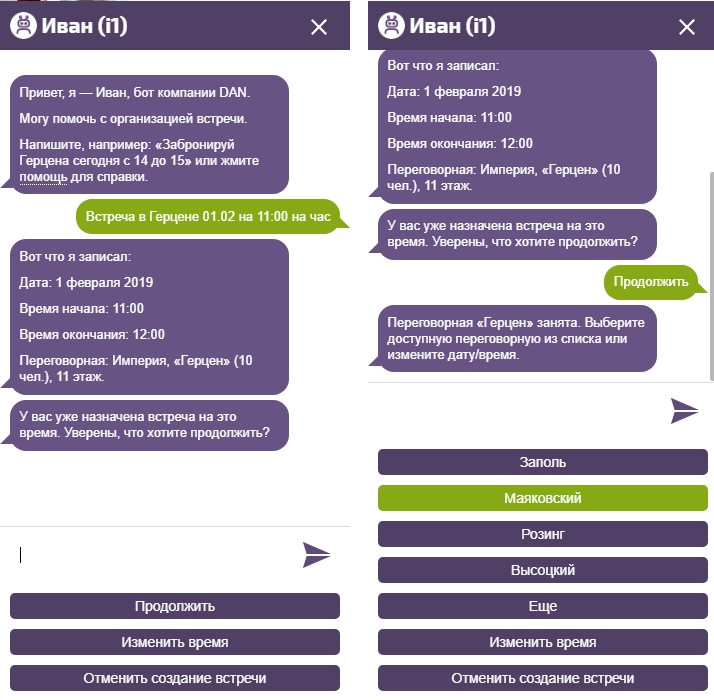
We specify the time and date of the meeting, as well as select the meeting room

We confirm all the meeting parameters and send invitations to the calendars
True, they left the widget on the portal in the hope that we could screw in some more more popular scripts there.
Result : negative , existing problems are solved by familiar tools, the new tool does not add additional value.
First positive experience
The end of 2018 was nearing and a colleague shared a VC article on the Telegram bot for the game "Secret Santa", which quickly found a response in our hearts. Firstly, as the experience of creating their own bots in Telegram, and secondly, as a kind of fan mechanics, involvement in which promised much more success than organizing meetings.
And since there was already an immovable deadline here, we decided to make the main scenario work, sacrificing beauty and variability. In fact, it turned out that the Telegram framework for working with bots allowed us not only to collect and test the bot in 2 weeks, but also to bring gloss, making communication more relaxed.
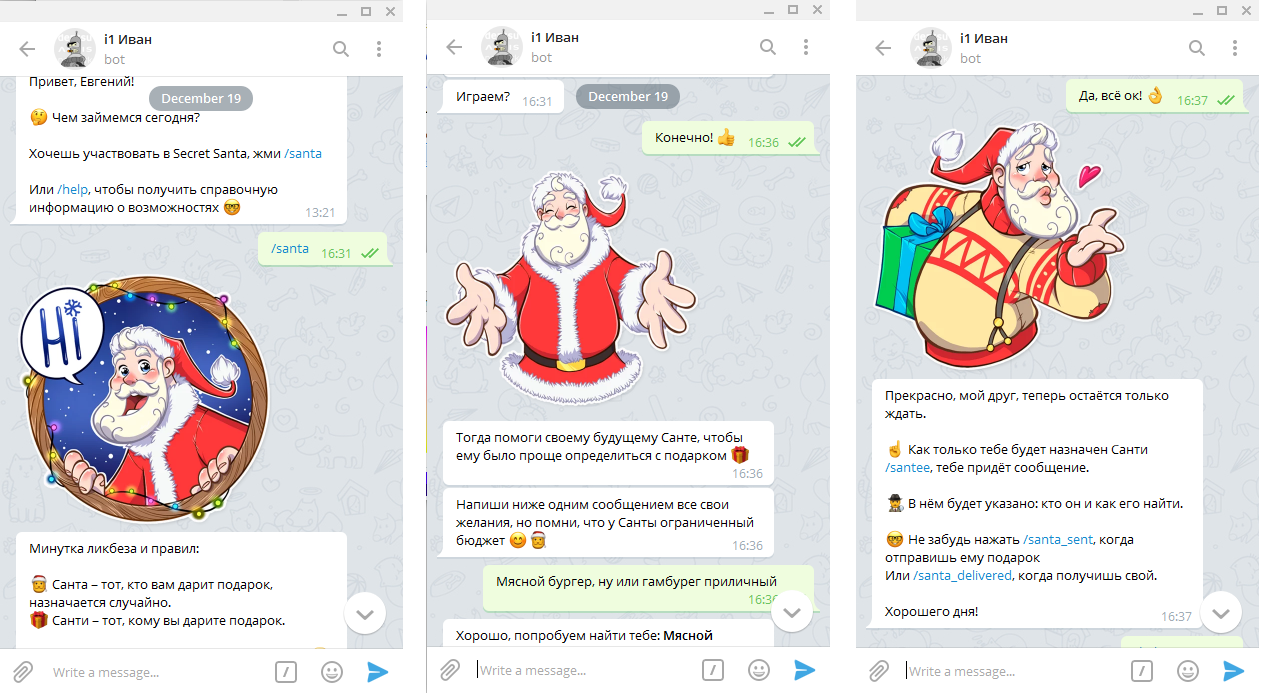
Despite the difficulties of working with Telegram in Russia, at that time about 50 people were involved in Secret Santa, 27 were able to exchange gifts.
At the level of the entire Dentsu Aegis Network group of companies, this was still a rather low indicator (3-5%), but we considered the experiment successful, because:
- The bot worked all the scenarios without crashing
- It became clear that employees were willing to invest their time in experiments, even without obvious benefits at the end of the experiment
- Info line has become a trigger for engagement
Result : positive , info occasion + fan mechanics = chance to get much more involved.
Birth of Ivan
In the same 2018, we were able to dive more into what is on the market of virtual assistants - the platforms on which they are assembled, and integrators who were ready to assemble a bot for any request and for any client’s budget.
But we wanted to solve some business problem, do it on our own (the benefit is internal expertise), technologically, without creating an army of bots in different channels (widget on the portal, Telegram, Lync / Teams messenger) and not getting out too much from the budget of the experimental direction.
So we met with autofaq.ai , and the guys talked about their main product, the task of which is to help in answering repetitive questions in different, but close in meaning, formulations through the use of deep neural networks and mechanisms for retraining the base with answers.
Here we remembered our initial idea - to answer questions from employees in different formulations, analyzing additional information in the context of a request from an employee. So the first demo prototype of the chat bot based on Telegram appeared:
We called him “Ivan” (i1, read like an i-van), this is not from the meager intelligence of our hero (all coincidences are random), but rather, due to the platform’s single naming (A1, B1, D1, I1, M1, V1 ), which we recently came to.
The prototype was well received by the employees, as part of a survey conducted after the demonstration, 105 people voted that the idea is great and they are ready to use it in their work.
When we reached the stage of primary filling of the base, we encountered the following difficulties:
- replenishment of the database with answers or adding synonyms to questions is the same work as the answers to these questions in chat rooms, in the mail and this requires a separate person or group of people
- the lack of online operators to switch to when the chat bot does not know the answer
- lack of feedback for the employee when his question appears in the answer database
- contractor API change rate to implement the logic of working with a chat bot without mechanics with operators
Result : negative , complex mechanics of replenishing the knowledge base of answers, lack of economic effect, even delayed, the need to recruit online operators.
Growing up Ivan
In 2019, we already got a little cooler about the topic of chat bots, but in the summer stars randomly formed:
- Outbound corporate event (#WellDAN) for employees planned
- The Dentsu Aegis Network realized that we can be given a deep knowledge of the Instagram audience.
- Algorithms and open libraries for face recognition in the photo worked well

And we decided that the chatbot Ivan in Telegram will work on the corporate party, which will be able to:
- Tell about the event, transfers, show the program and location map
- Check employee at an event
- Find colleagues in the photo and talk about their interests by analyzing open Instagram profiles
Initially, the mechanics were very complex, sometimes not very logical, but we were able to reduce them to a simple and understandable scenario:
1. Employees receive a letter on the day of the event with a description of what the chatbot Ivan can do.
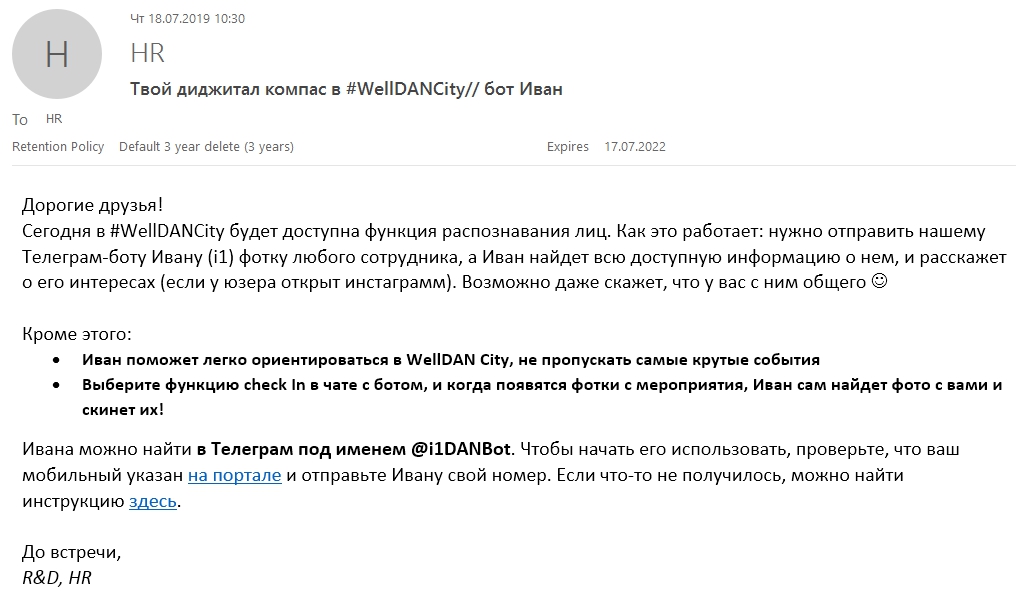
2. The employee arrives at the event, performs a check-in, sending any number of his selfie photos - you need to send his photos from the event later

3. Activates different bot commands
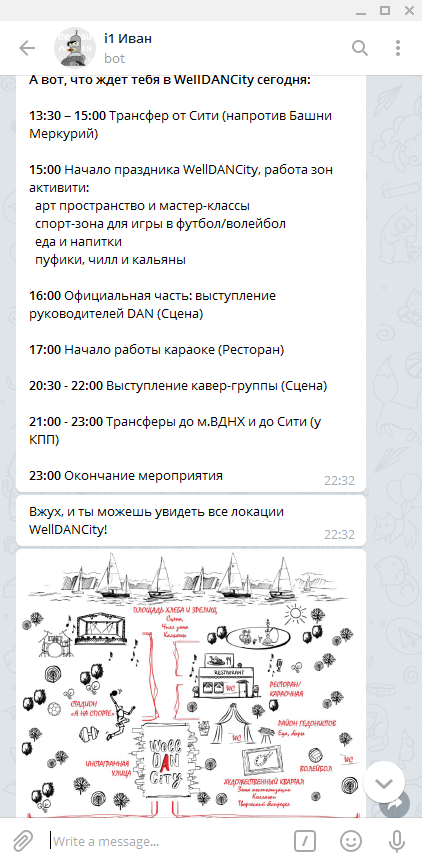
4. Checks how the search for colleagues in the photo works, and whether you have common interests based on information from Instagram
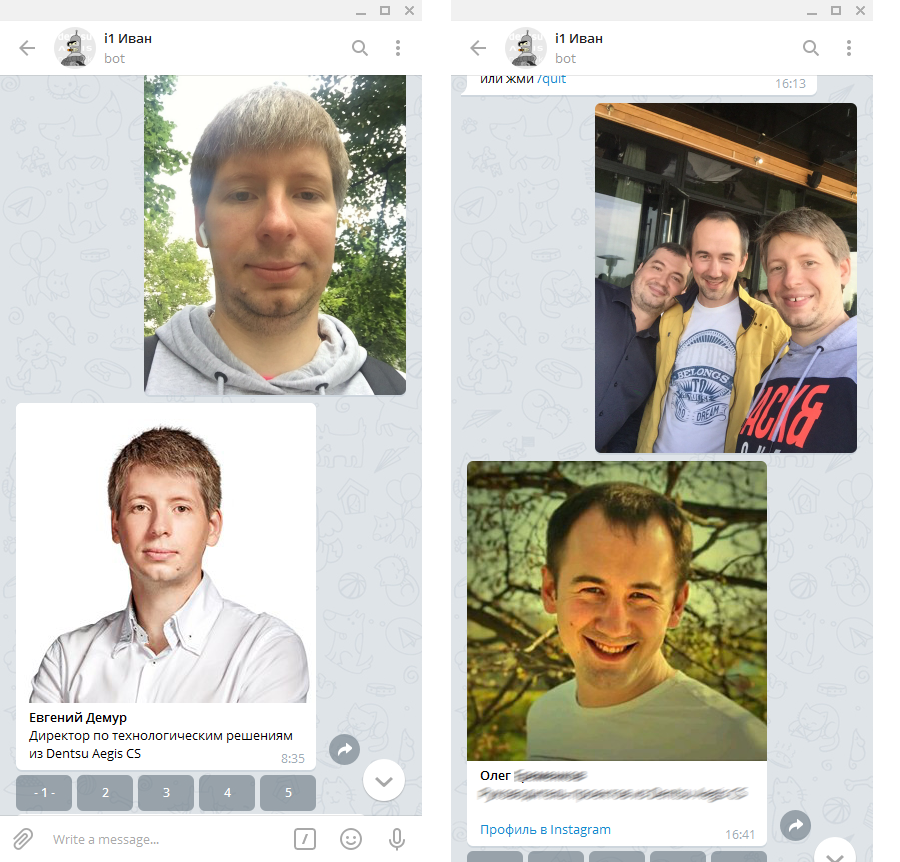
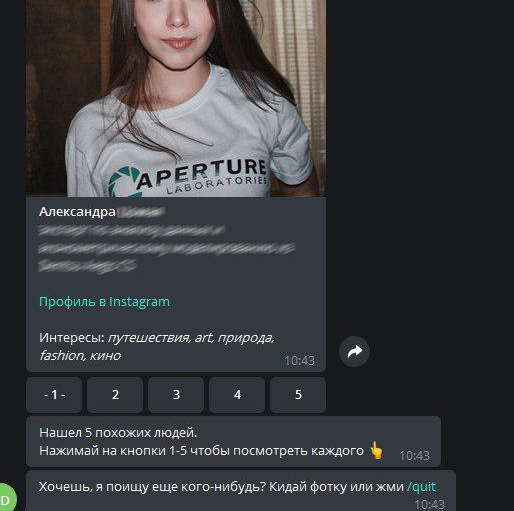
As a result, thanks to such fan mechanics, 2403 messages were sent through the bot on the day of the event, and 137 people took advantage of the bot:
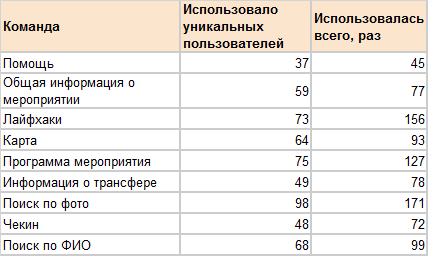
Result : positive , understandable mechanics, the presence of an informational relevant to most employees, mobile, as a priority channel, as well as reuse of the chat bot platform.
Epilogue and the freezing of Ivan
After the summer corporate event, our chatbot still worked at a group conference for clients and partners. But one way or another, it came down either to one-time events for specific informational occasions, or was purely entertaining in nature.
Therefore, at the moment we have decided to “freeze” this direction, in the hope that in the future we will be able to find a niche in which chatbots will work better than traditional interfaces that people are used to (search bar, data entry form, pages FAQ), or they will have no analogues at all or have an advantage in the speed of resolving issues. For example, going through the voice menu 8-800 through a script in a chatbot instead of using tone commands from the phone.
So before you start developing your own chatbot or voice assistant, try to start by studying successful and not-so-good cases. Then there is a non-zero probability that your experiments will lead to the creation of a really useful, convenient and popular product or service, which will subsequently become an incentive for the development of a communication environment where chat bots